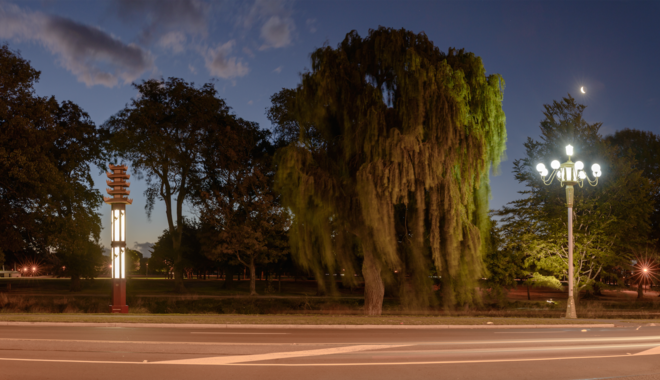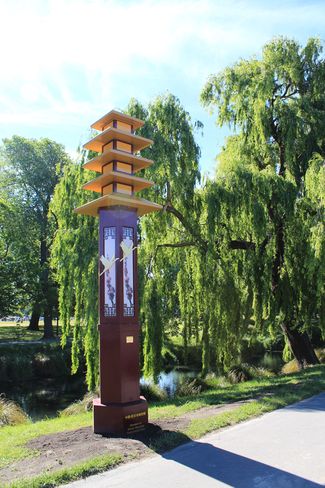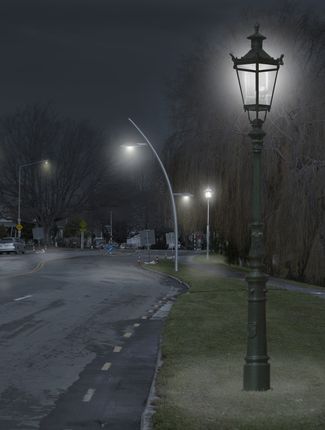
| Project | public preposition Solidarity Grid |
| Year | 2013–2015 |
| Institution | SCAPE 7 Public Art Christchurch Biennial, 2013 /NZ SCAPE 8 Public Art Christchurch Biennial, 2015 /NZ |
| Place | Park Terrace, Christchurch /NZ |
| Curator | Blair French |
| Technique | 22 street lamps, brass plates |
| Thanks | Maria Adamski, Michael Aitken, Pat Barrow, Bob Blyth, Stephanie Brown, Michelle Callingham, Jack Chaney, Jimmy Chen, Mark Christensen, Phil Clearwater, Anna Colthart, Pauline Cotter, Paige Cuthbert, Lianne Dalziel, David East, Karleen Edwards, Geoff English, Anastasia Farrakhova, Michael Fulton, Rob Garrett, Darryn George, Jamie Gough, Neil “Grumpy” Graham, Martin Hadlee, Jenny Harper, Wolfgang Heinen, Quin Henderson, Michael Hennessy, Chris Hill, Lucy Hunter, Yani Johanson, Ben Johnston, Ali Jones, Yolande Lawrence, Jane Leighs, Glen Livingstone, Paul Lonsdale, Jo Mair, Raf Manji, Jenny May, Deborah McCormick, Sue McFarlane, McFarlane, Kate Montgomery, Jane Parfitt, Rainer Pennekamp, Ulrike Rosenfeld, Tim Scandrett, Bettina Senff, Tony Sewell, Ray Sidon, Allan Stephenson, Dame Adrienne Stewart, Lara Strongman, Simon Taylor, Andrew Turner, Jose Whelan, Elizabeth Wilson, Elaine Wong, Anthony Wright |
| Photographer | John Collie, Christchurch /NZ Susan Zhu, Christchurch /NZ Yumi Nakajima, Sendai /JPN SCAPE Public Art, Christchurch /NZ Archive Mischa Kuball, Düsseldorf /DE |
| Supported by | Christchurch City Council, Aurecon, Anderson Lloys Lawyers, The Press, Mainfreight, Neil “Grumpy” Graham, Philips /NZ |
Solidarity Grid, Christchurch, 2013–2015
Christchurch, the second largest city in NewZealand, was severely affected by earthquakes in 2010 and 2011. A majority of landmark buildings and houses were destroyed. On the occasion of the SCAPE Public Art Christchurch Biennial and as a sign of solidarity, Mischa Kuball developed the installation “Solidarity Grid.” On request, 22 street lamps from different countries were donated over the course of three years and were permanently installed along Park Terrace. All the lamps differed from one another in design, size, and cultural-historical background. In their new location, reached by complex communication and logistical processes, their symbolic and social significance extends. At the same time they retain their original function as light sources and are a practical contribution to the rebuilding of Christchurch. After the end of the project in 2015, the lamps will remain a symbolic monument of the changing city. (JO)
Solidarity Grid
by Vanessa Joan Müller
Prepositions are a grammatically distinct class of words that express spatial or temporal relations or serve to mark syntactic functions and semantic roles. A preposition typically combines with another constituent to form a prepositional phrase, thus relating the complement to the context in which the phrase occurs.
In Mischa Kuball’s series of works and interventions called public prepositions the preposition refers to connecting words such as “and”, “but” and “or”, i.e. the words in between a specific, often historical site and the intervention. public prepositions are temporary or permanent works for public spheres that facilitate thoughts and discussions about the artwork and its siting. These works emphasise spatial and socio-political aspects of a given context and change the experience of place. They range from the redevelopment of lighting systems within existing structures to purely conceptual projects. By using the medium of light Kuball develops architectural interventions that highlight a specific context or reprogram a given space. Many of them are participatory projects where the borders of private and public space are redefined. The dialogue between artist, artwork and the public is the main aspect of these site-specific works.
Solidarity Grid, which was developed for the SCAPE Public Art Biennial Christchurch, is an infrastructure replacement project and part of the public prepositions series. It is an artwork that arose out of a deficiency. Starting with a replica of a 19th century gaslight that was gifted from his hometown Düsseldorf, Kuball designed a grid of twenty-one streetlights from different cultural contexts that will be installed along the walkway to the east of North Hagley Park on Park Terrace and illuminate it at dark. The street lamps come from cities such as Belgrade (Serbia), Kurashiki (Japan), Adelaide and Sydney (Australia) and operate as part of the Christchurch public streetlight grid. Each of the lamps is characterised by a precise locality and introduces different ideas of urban planning and understandings of historicism to the city. Together, they set up a functional lighting that connects an urban situation with similar environments in other places.
Reacting to the possibilities presented by a given situation is part of Kuball’s artistic strategy. Solidarity Grid is an apparently simple (though logistically elaborate) intervention that suffices to effect a change. It is based on objects and forms that already exist and are functionally bound to a specific locale. Moving an object from its original context to another is a method often employed by contemporary art. The object is abstracted from its function and significance in its former context, both bringing a transformation of the new context into which is shifted, and giving the object a new meaning within this context. Usually the artefact undergoes irreversible change in this process as it is impossible for it to return to its former function and former semantic context. It is transformed into a part of a new artistic work. The lampposts, however, are donated by the cities they come from. They are just relocated and retain their function and the semantic predicates that imply their original context. They still belong to a specific place — their own place — which emphasises their displacement. They also differ in various respects (design, size, historical background) and are charged with meaning relating to a place elsewhere. By transposing their specific locale to Christchurch they become abstract signifiers for the idea of belonging to a place.
Lampposts are indicators of modern city life, but can also add a nostalgic element to the notion of urbanism. The design of the Düsseldorf streetlight for instance is a response to the city’s longing for signs of historicity. Heavily destroyed during the Second World War, Düsseldorf aimed at becoming a modern city with an international skyline. The gaslight replicas, which were installed in the historical city centre only a few years ago, add an idea of late 19th century city life to this generic look in order to keep the past alive.
Solidarity Grid is surrounded by intense communication and shipping logistics. An important element of the work thus is its very own development: the donation of the lamppost by the partner cities and their shipment to New Zealand. The grid’s presence in Christchurch is only the project’s final visible manifestation, and the journey of the different elements constituting Solidarity Grid an integral part of it.
Hence Solidarity Grid manifests itself not only on location. Some parts of the project remain invisible to the audience and the cities’ inhabitants. These parts tell their own story of absence and memory. When the project will be finished in 2016, it will be a temporary monument to the city’s ongoing transformation and an addition to the regular streetlight grid. Familiar and distant at the same time, it will encourage our thinking about a city’s history, present and future, and how an everyday object like a lamp can create a narrative about a place and how we belong to it.




Press
- Hurrel, John, "Solidarity Grid Publication", in: eyecontactsite, 26.06.2018.
- Hurrell, John, "Kuball's Solidarity Grid", in: eyecontactsite, 15.10.2016.
- Moore, Christopher, "State of Arts: Solidarity Grid lighting up Christchurch's Park Terrace", in: stuff, 11.12.2015.
- Price, Anna, „Light shed on city’s Polish heritage“, in: stuff, 08.12.2015.
- o.A., „New Solidarity Grid Lamp to Remind of Fight for Poland’s Political Freedom“, in: Manatu Taonga – Ministry for Culture & Heritage, 01.12.2015.
- Feeney, Warren, „Park Terrace lights a show of Solidarity“, in: stuff, 27.10.2015.
- o.A., „Chrina, New Zealand: Gansu’s Street Lamp Installed along Park Terrace as Part of Mischa Kuball’s Progressive Art Project“, in: High beam, 05.10.2015.
- o.A., „Street Lamp Brings French touch to ‚Solidarity Grid’“, in: Manatu Taonga – Ministry for Culture & Heritage, 30.09.2015.
- SCAPE Public Art, „Street Lamp Brings French touch to ‚Solidarity Grid’“, in: Scoop Culture – independent news, 30.09.2015.
- o.A., „Solidarity Grid: Straßenlicht aus aller Welt erhellt Christchurch“, in: smart Light & living, 21.05.2014.
- o.A., „Mischa Kuballs Kunstprojekt Solidarity Grid“, in: xity – wir in der region, 11.09.2013.
- SCAPE Public Art, „Lighting up Christchurch“, in: The Big Idea, 12.09.2013.
- Haas-Pilwat, Dagmar, „Mischa Kuball bringt Laternen nach Neuseeland“, in: rp online, 12.09.2013.
__________________________________________________________
"Solidarity Grid - ein Licht für Christchurch" / reception at city hall of Duesseldorf

It was a pleasure and a real honour for us to welcome a delegation of ten guests from Christchurch for a reception with the mayor Thomas Geisel at the city hall of Duesseldorf on 11th June 2017. On that occasion Duesseldorf represented by Thomas Geisel received an edition for the project "Solidarity Grid" by Mischa Kuball as a gift from the delegation represented by Dame Adrienne Stewart (SCAPE Public Art Advocate, Christchurch) and Deborah McCormick (Director, SCAPE Public Art, Christchurch).
__________________________________________________________
Publication "Solidarity Grid"
2017: Mischa Kuball: Solidarity Grid - Otautahi Christchurch 2013-2016, hrsg. von / ed. by Blair French. Koenig Books, London.
